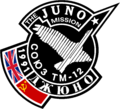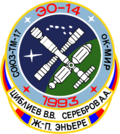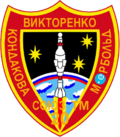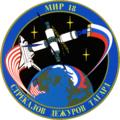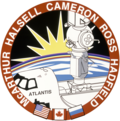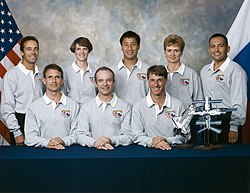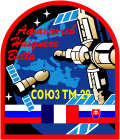Top Qs
Timeline
Chat
Perspective
List of human spaceflights to Mir
From Wikipedia, the free encyclopedia
Remove ads
Human spaceflights were vital to the operation of Mir, allowing crews and equipment to be carried to and from the space station. Mir was visited by a total of 39 crewed missions, comprising 30 Soyuz flights (1 Soyuz-T, 29 Soyuz-TM) and 9 Space Shuttle flights. These missions carried both long-duration crew members flying principal expeditions (ranging from 70 days up to Valeri Polyakov's 14-month stay beginning in January 1994, which still holds the record for the longest continuous spaceflight by a single person) and short-term visitors (who spent about a week aboard the station). Many of the crew who visited Mir used different spacecraft to launch than they did to land; the first such examples were Aleksandr Viktorenko and Muhammed Faris who flew up in Soyuz TM-3 (launched 22 July 1987) and landed a week later in Soyuz TM-2 on 30 July 1987. The largest crew aboard Mir simultaneously (not including Shuttle-Mir missions) was 6, which first occurred with the launch of Soyuz TM-7 on 26 November 1988 and lasted for just over three weeks.

Mir (Russian: Мир, IPA: [ˈmʲir]; lit. 'peace' or 'world') was a space station operated in low Earth orbit from 1986 to 2001, first by the Soviet Union and later by the Russian Federation. Mir was the first modular space station and was assembled in orbit from 1986 to 1996. It had a greater mass than any previous spacecraft. At the time it was the largest artificial satellite in orbit, succeeded by the International Space Station (ISS) after Mir's deorbiting. The station served as a microgravity research laboratory in which crews conducted experiments in biology, human biology, physics, astronomy, meteorology, and spacecraft systems with a goal of developing technologies required for permanent occupation of space.
Following the success of the Salyut programme, Mir represented the next stage in the Soviet Union's space station programme. The first module of the station, known as the core module or base block, was launched in 1986 and followed by six further modules. Proton rockets were used to launch all of its components except for the docking module, which was installed by US Space Shuttle mission STS-74 in 1995. When complete, the station consisted of seven pressurised modules and several unpressurised components. Power was provided by several photovoltaic arrays attached directly to the modules. The station was maintained at an orbit between 296 and 421 km (184 and 262 mi) altitude and travelled at an average speed of 27,700 km/h (17,200 mph), completing 15.7 orbits per day.[1][2][page needed][3]In this list, uncrewed visiting spacecraft are excluded (see List of uncrewed spaceflights to Mir for details), and long-duration crew members are listed in bold. Times are given in Coordinated Universal Time (UTC). "Time docked" refers to the spacecraft and does not necessarily correspond to the crew.
Remove ads
See also
References
External links
Wikiwand - on
Seamless Wikipedia browsing. On steroids.
Remove ads









